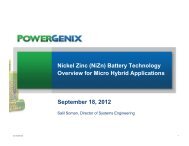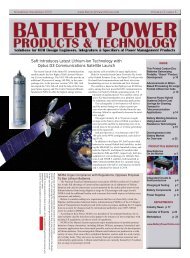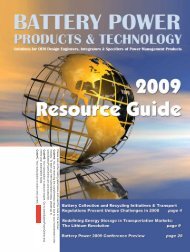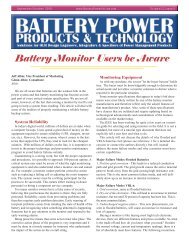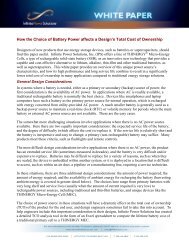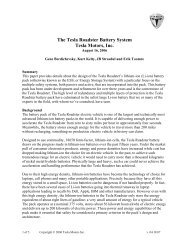Battery Management Systems - Battery Power Magazine
Battery Management Systems - Battery Power Magazine
Battery Management Systems - Battery Power Magazine
Create successful ePaper yourself
Turn your PDF publications into a flip-book with our unique Google optimized e-Paper software.
Editor’s Choice<br />
Editor’s Choice<br />
GM Builds First Lithium-Ion <strong>Battery</strong> for Chevrolet Volt<br />
Exactly three years since the<br />
day the Chevrolet Volt concept car<br />
debuted, GM has manufactured the<br />
first advanced lithium-ion battery for<br />
a mass-marketed electric vehicle at<br />
GM’s Brownstown <strong>Battery</strong> Pack Assembly<br />
Plant.<br />
GM announced last August a<br />
$43-million investment to prepare<br />
the 160,000 square-foot, landfill-free<br />
facility for production of lithium-ion<br />
battery packs for the Volt and other<br />
electric vehicles with extended-range capabilities. The plant is part of a whollyowned<br />
subsidiary of General Motors called GM Subsystems Manufacturing LLC.<br />
In five months, the Brownstown plant was converted from an empty facility to a<br />
production-ready battery manufacturing site. New machinery and specialized equipment<br />
have been installed and three primary assembly areas have been completed:<br />
battery module pre-assembly, final assembly and the battery pack main line.<br />
The Volt’s battery pack is made up of multiple linked battery modules and more<br />
than 200 battery cells. The initial assembly area is where the prismatic-shaped cells are<br />
processed and installed by state-of-the-art flexible automated equipment into modules,<br />
which are then delivered to the battery pack main line.<br />
The battery pack main line area features an Automated Guided Cart (ACG) system<br />
that includes operations for thermal and electrical assembly, along with quality and<br />
dimensional checks. The main line is also where battery pack final testing, verification<br />
and packaging for shipment take place.<br />
Initial battery production at Brownstown will be used to validate the plant’s equipment<br />
and processes, and batteries will be sent to GM’s Global <strong>Battery</strong> <strong>Systems</strong> lab in<br />
Warren, Mich., for testing. This spring, GM will begin shipping batteries to GM’s Detroit-Hamtramck<br />
plant, the assembly location<br />
for the Volt, for use in production validation<br />
vehicles. Regular production at Brownstown<br />
and Detroit-Hamtramck is set to begin in the<br />
fourth quarter.<br />
GM is investing $700 million in eight<br />
Michigan facilities for Volt-related production,<br />
including $336 million in the Detroit-Hamtramck<br />
plant, which will benefit from battery<br />
research conducted at the battery lab in Warren;<br />
receive batteries from Brownstown; use tooling<br />
from Grand Blanc; take delivery of camshafts<br />
and connecting rods from Bay City; and dies,<br />
stampings and the Volt’s 1.4L engine-generator from three plants in Flint.<br />
The Volt is an electric vehicle with extended-range capability. It is designed to drive<br />
up to 40 miles on electricity without using gasoline or producing tailpipe emissions.<br />
When the Volt’s lithium-ion battery is depleted of energy, a flex-fuel engine-generator<br />
seamlessly operates to extend the total driving range to about 300 miles before refueling<br />
or stopping to recharge the battery.<br />
NREL Evaluates UPS Hybrid-Electric Van Performance<br />
The US Department of Energy’s (DOE) National Renewable Energy Laboratory<br />
(NREL) has collected and analyzed fuel economy, maintenance and other vehicle performance<br />
data from UPS’s first generation hybrid diesel step delivery vans powered by<br />
an Eaton Corp. electric hybrid propulsion system.<br />
Photo Courtesy of GM Corp.<br />
Editor & Publisher • David Webster<br />
Director of Content • Shannon Given<br />
Associate Editors • Nick Depperschmidt,<br />
Heather Krier<br />
News Editors • Jeremy Fleming,<br />
Jessi Albers, Sue Hannebrink, Laura Mayo<br />
Manager of Administration<br />
Marsha Grillo<br />
Advertising, Sales and Marketing<br />
Jessi Albers, Director of Sales<br />
Jeremy Fleming, Account Executive<br />
Jennifer Graham, Marketing Assistant<br />
Julie Hammond, Production Manager<br />
Director of Support Services<br />
Marc Vang<br />
BATTERY POWER (ISSN #1092-3616)<br />
is published bi-monthly by Webcom Communications<br />
Corp., 7355 E. Orchard, #100<br />
Greenwood Village, CO 80111. Free for<br />
the qualified US $58.00 non-qualified US<br />
and $72.00 elsewhere.<br />
Periodicals Postage paid at Englewood, CO<br />
and additional mailing offices.<br />
POSTMASTER:<br />
Send address changes to:<br />
Webcom Communications<br />
7355 E. Orchard, #100<br />
Greenwood Village, CO 80111<br />
Reprints/Photocopies: For requests contact<br />
Webcom Communications at<br />
720-528-3770.<br />
© Copyright 2010 Webcom Communications<br />
Corp. Material in this publication<br />
may not be reproduced in any form without<br />
written permission. Requests for permission<br />
should be directed to the customer<br />
service manager.<br />
Webcom Communications Corp.<br />
7355 E. Orchard Rd., Suite 100<br />
Greenwood Village, CO 80111<br />
Phone 720-528-3770 • Fax 720-528-3771<br />
www.<strong>Battery</strong><strong>Power</strong>Online.com<br />
Office hours: 7 a.m. to 5 p.m. MST<br />
The diesel hybrid delivery vans improved the on-road fuel<br />
economy by 28.9 percent resulting in a 15 percent improvement<br />
in total cost per mile while maintaining similar reliability and<br />
operational performance as compared to conventional vehicles.<br />
Funded by the DOE’s Advanced Vehicle Testing Activity<br />
(AVTA), NREL’s Fleet Test & Evaluation (FT&E) team performed<br />
a 12 month evaluation of six of these hybrid vans at a<br />
UPS location in Phoenix.<br />
The report details the year-long demonstration project,<br />
including how the FT&E team collected and analyzed fuel<br />
economy, maintenance and other vehicle performance data on<br />
the vans, which are being used in delivery service. The project<br />
also tested a conventional and hybrid delivery van in NREL’s<br />
ReFUEL laboratory in Denver, Colo., and documented fuel<br />
economy and emissions performance on various test cycles.<br />
Eaton Corp. provided the hybrid propulsion systems for the<br />
vehicles, which were manufactured by Freightliner Corp. The<br />
hybrid system employs an Eaton automated transmission with<br />
an integrated motor/generator and advanced lithium ion batteries.<br />
Both the Freightliner hybrid model and the conventional<br />
model use a Mercedes-Benz MBE 904 four-cylinder diesel engine.<br />
UPS has recently ordered an additional 200 Eaton hybrid<br />
electric powered vans.<br />
The Eaton hybrid system was developed in part under a<br />
previous $7.5 million, 33 month contract from DOE’s Advanced<br />
Heavy Hybrid Propulsion System program.<br />
Limit Widespread Adoption of Electric Cars Over the<br />
Next Decade, Says The Boston Consulting Group<br />
Although electric-car battery costs are expected to fall sharply<br />
over the coming decade, they are unlikely to drop enough to<br />
spark widespread adoption of fully electric vehicles without a<br />
major breakthrough in battery technology, according to a new<br />
study by The Boston Consulting Group (BCG).<br />
The study concludes that the long-term cost target used<br />
by many carmakers in planning their future fleets of electric<br />
cars, $250 per kilowatt-hour (kWh), is unlikely to be achieved<br />
unless there is a major breakthrough in battery chemistry that<br />
substantially increases the energy a battery can store without<br />
significantly increasing the cost of either battery materials or the<br />
manufacturing process.<br />
“Given current technology options, we see substantial challenges<br />
to achieving this goal by 2020,” said Xavier Mosquet,<br />
Detroit-based leader of BCG’s global automotive practice and a<br />
coauthor of the study. “For years, people have been saying that<br />
one of the keys to reducing our dependency on fossil fuels is the<br />
electrification of the vehicle fleet. The reality is, electric-car batteries<br />
are both too expensive and too technologically limited for<br />
this to happen in the foreseeable future.”<br />
Most electric cars in the new decade will use lithium-ion<br />
batteries, which are lighter and more powerful than the nickelmetal<br />
hydride (NiMH) batteries used today in hybrids like the<br />
4 <strong>Battery</strong> <strong>Power</strong> • March/April<br />
www.<strong>Battery</strong><strong>Power</strong>Online.com<br />
www.<strong>Battery</strong><strong>Power</strong>Online.com March/April • <strong>Battery</strong> <strong>Power</strong> 5



